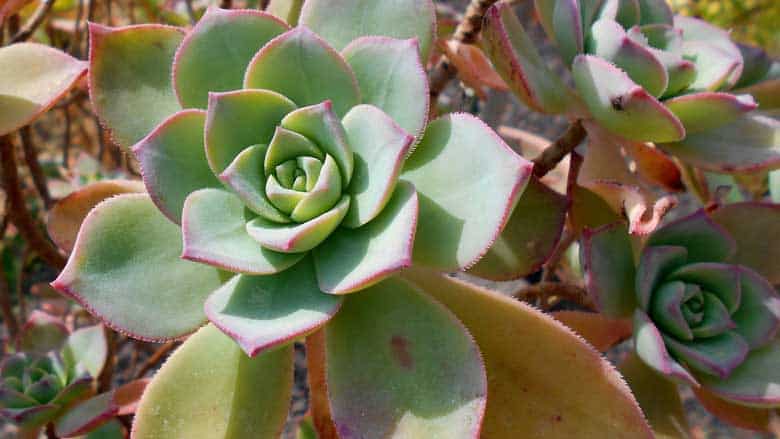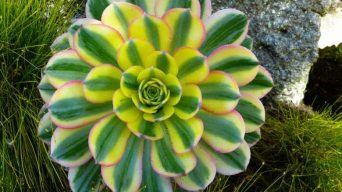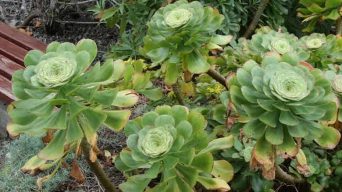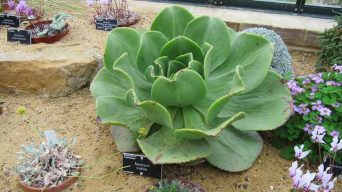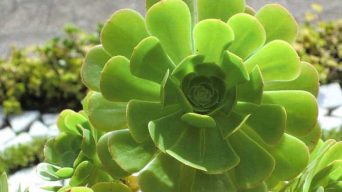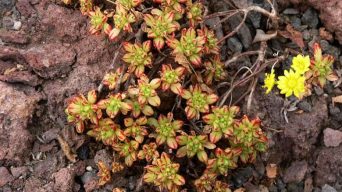This article is a must-read if you are a beginner gardener or a succulent enthusiast.
The Aeonium haworthii plant is one of the most popular succulents for several reasons.
It’s relatively easy to care for and propagate. It has a beautiful shape with a unique color scheme and can tolerate drought conditions in your garden.
In this guide, we will cover everything you need to know about taking care of an Aeonium haworthii plant so that you can have success in the garden!
Overview
| Family: | Crassulaceae |
| Genus: | Aeonium |
| Botanical Name: | Aeonium haworthii |
| Synonyms: | Sempervivum haworthii |
| Common Names: | Pinwheel, Pinwheel Aeonium, and Haworth’s Aeonium |
| Origin: | Canary Islands and northern Africa |
| USDA Hardiness Zones: | 9 – 11 |
| Size: | Up to 2 feet (60 cm) in height and up to 4 inches (10 cm) |
| Sun Exposure: | Full sun to partial shade |
| Water Needs: | Water thoroughly but infrequently |
| Soil Type: | Well-draining soil |
| Temperature: | 65-75° Fahrenheit (18-24 Celsius) during daytime hours and 60°F (15°C) at night |
| Humidity Levels: | 50-60% |
The Aeonium haworthii is a succulent flowering plant commonly known as Pinwheel, Pinwheel Aeonium, and Haworth’s Aeonium.
It is a winter-growing succulent native to the Canary Islands and Northern Africa.
The Aeonium haworthii shrub is a freely growing succulent plant that can reach up to 2 feet (60 cm) in height.
This Aeonium species tend to have rosettes that can grow up to 4 inches (10 cm) in diameter with bluish-green leaves with a brownish-red edge.
It has pinkish-yellow flowers that rise above the fleshy leaves in a large cluster. They grow on a tall stem that is also covered with small leaves.
How To Care for Aeonium Haworthii (Pinwheel)
Aeonium haworthii care is a straightforward process.
The following are the main points to provide proper care for a Pinwheel Aeonium succulent.
Sun Exposure & Light Requirements
Aeonium haworthii plants should be grown in either full sun or partial shade.
When grown outdoors, you should plant aeonium haworthii plants in a location that receives at least six hours of direct sunlight daily.
Provide shade from the midday summer heat by placing a tree nearby or other shading structure.
Aeonium haworthii plants require a lot of bright light but do not like sunburn.
The best way to grow these succulents indoors is with a bright, sunny window with southern or western exposure.
They need a minimum of four hours a day of filtered bright light.
Watering Requirements
It is a good idea to water Aeonium haworthii succulents only when the soil starts feeling dry and never so often that any excess water stays in the pot.
The best way to tell if it is time for a new watering, poke your finger into the soil about an inch down and see how moist or wet it feels.
If you feel some moisture, then wait a day before watering again.
This plant does not like being overwatered, so it’s essential to monitor the watering frequency and stay on a regular schedule.
Water Aeonium haworthii plants sparingly so that water settles in the soil.
The Pinwheel plant does not like having its roots wet, which can lead to root rot if the top layer of soil is constantly moistened.
Soil Requirements
Aeonium haworthii care a great deal about their soil. It must be porous and nutrient-rich, so a succulent mix is a good choice for indoor growing these plants.
When grown in the ground, they like loose, well-drained soils with a pH of around neutral to mildly acidic.
When cultivated in containers, the potting mix must be fast draining and rich in nutrients.
A succulent soil mix is ideal when cultivating them in pots. It has all the things that succulents need:
- Peat moss keeps the plant moist.
- Perlite gives air space.
- Sand/gravel drains water.
- Cow manure provides nitrogen and other compounds to help the plant grow.
Temperature and Humidity
Aeonium haworthii plants need a temperature between 65-75 degrees Fahrenheit (12-26 Celsius) during daytime hours and 60 degrees at night.
They also prefer a humidity level of 50-60%, a little on the dry side.
You should monitor temperature and humidity throughout the day for the plant to thrive.
If a pot is left in a room with an air conditioner, it may experience a sudden change that could eventually damage the roots or even kill the plant.
The same goes for plants being brought into a room from outside on a cold winter night. They should gradually adjust and not go too quickly from one extreme temperature to another.
Fertilizing
Aeonium haworthii succulents are drought-resistant and low-maintenance plants.
However, Aeoniums still need a nutrient element they can’t get from soil alone, so fertilizing will be required to keep them healthy.
A typical time frame for fertilizer application is once per year. Monthly applications may damage the roots by burning off cilia, protecting them against pests and disease.
The best time of the year for this is during the growing season with a balanced, water-soluble fertilizer diluted to half strength. This will keep Aeoniums healthy all year round.
Potting and Repotting
Aeonium haworthii is a succulent plant that requires a deep pot to grow in.
When repotting, water the soil thoroughly and then allow it to drain before placing it into the new container.
You can use a mix of sand or perlite mixed with a good quality cactus or succulent potting soil for best results when planting your Aeonium haworthii.
If a plant is in a too-small pot, the roots will start to circle and grow outward from each other. This could lead to rot on the base of your plant.
When you repot a container-bound succulent like Aeonium haworthii, it can be helpful to prune off excess roots circling outwards so they don’t become entangled with those at the center.
After cutting through any long root strands, leave them for several days before watering again. This will allow new cells in cut areas to seal before getting wet and reopening wounds.
Pruning
Aeonium haworthii is a succulent plant that you must prune from time to time.
They typically grow a few inches a year; if not pruned, they will eventually make a bush.
To prune the Aeonium haworthii:
- Cut off any dead or yellow leaves.
- Prune back the tallest stem from other stems to encourage more branching growth.
- Cut any broken stems with clean cuts just above a healthy branch, promoting new growth.
- Remove spent flower spikes when they wilt to prevent rotting on the stem base near the soil level.
- Remove Aeoniums that have grown in a way you don’t want to encourage or if they are too close together.
Pests and Diseases
Aeonium haworthii plants are very resilient plants with a few pests and diseases that can be problematic.
The most common issue is root rot due to being watered too often or from overwatering.
If you see signs of red, brown, and yellow leaves at the base that fall off when touched, this could indicate a potential problem.
Root rot will kill your succulents if not tended to properly, so it’s best to address any issues before they get out of hand.
The most common pests Aeonium haworthii has are:
- Mealybugs
- Aphids
- Spider Mites
If a pest infestation becomes a concern for your succulents, use a soap and water mixture sprayed directly onto the pests. This will burn them off from your succulent leaves without harming them significantly.
The best way to prevent pests and diseases is to thoroughly inspect your plants regularly.
Aeonium haworthii succulents are resilient, but pests and diseases can be significant problems if not dealt with soon enough.
It’s best to keep an eye out for any potential issues so you can address them as they arise.
How to Care for Aeonium Haworthii in Winter
Aeonium haworthii plants are winter-growing succulents, and you should adjust Aeonium haworthii care accordingly.
When it comes to winter care for Aeonium haworthii plants, you’ll need to ensure they’re not exposed to too much cold or dampness.
Here’s what you should do:
- Keep them out of drafts from doors and windows by misting them with water every other day as needed.
- Be careful when watering your plant – don’t let any excess moisture stand on its leaves because this may lead to rot.
- Keep Aeoniums on the dry side.
- Move pots to a spot with a warmer, south-facing window – this way, they’ll get enough light without being too hot.
- If it’s impossible to find a sunny spot indoors for your plant, place it in a cool room free from drafts and away from heating vents.
- Place Aeoniums in a pot with well-draining, coarse soil.
- If your plant is outdoors and has suffered from the cold winter weather, you should bring it inside as soon as possible to avoid frost or browning of the leaves and rot.
How To Propagate Aeonium Haworthii (Pinwheel)
Aeonium haworthii can be easily propagated by cuttings.
To propagate Aeonium haworthii, you will need a mature Aeonium plant to take the cutting from.
Look for a healthy-looking one with deep roots firmly planted in the soil.
- Cut a healthy stem, at least 12 inches long, with a sharp knife.
- Remove the leaves from one end of the stem and allow them to be callous for a few days.
- Place a cutting in a shady location where it will not be disturbed while the callous seals over.
- Keep the soil wet but do not let it stay soggy or drown the plant.
- Once a callous has formed, you can plant the cutting in a pot or a rocky garden.
- Keep Aeoniums in a well-lit location.
The cuttings should root within a few weeks and grow into a new plant that you can propagate again to create more plants for yourself!
Is the Aeonium Haworthii Toxic?
As far as it is known, the Aeonium haworthii plant is not toxic to humans or animals.
However, aeonium haworthii plants are a type of succulent. So, the sap is acidic, like most other types of succulents.
So if you get any on your skin or mouth, rinse off with water immediately.
Final Thoughts
Aeonium haworthii plants are a perfect succulent for beginners and experts alike.
A healthy Aeonium haworthii plant can grow a few inches a year and live for a long time with little care.

